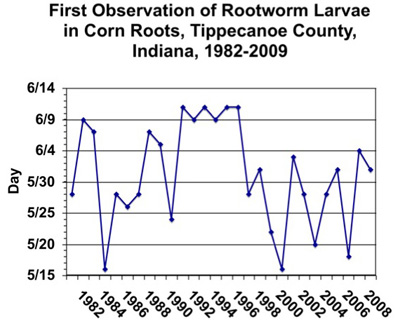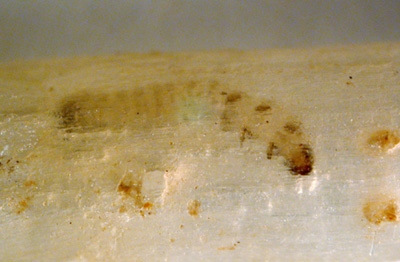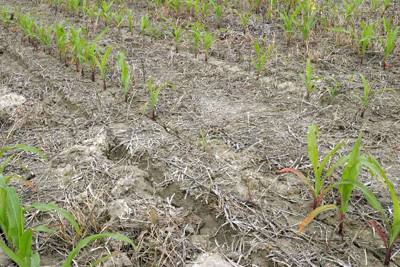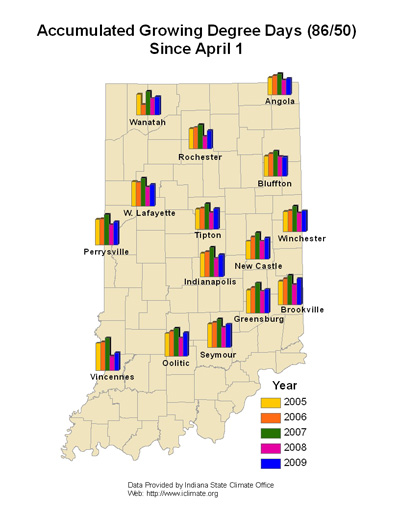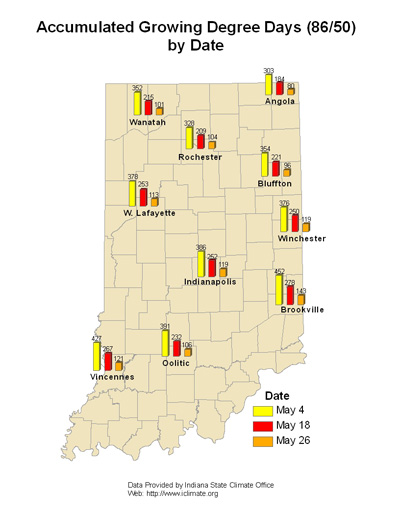Pest & Crop Newsletter, Entomology Extension, Purdue University
Nematode Updates, Corn Nematodes - (Jamal Faghihi, Christian Krupke, and Virginia Ferris)
This has been a cool and wet spring, perfect conditions for Needle nematodes to show their damage. Late corn planting will not prevent nematode damage. The nematodes remain active in the soil and wait for the young seedlings, and invade their young roots soon after germination. Young corn seedlings are vulnerable to the tiny nematodes as they aggregate around roots and with the aid of hollow needle-type mouth parts suck the juice out of the corn root. If these weather conditions persist, we anticipate that you will encounter problems from Needle nematode on corn. Needle nematode activity usually starts when soil temperatures reach 50°F and usually ceases when soil temperatures rise above 85°F. If you have noticed patches of stunted young corn seedlings in sandy soil, Needle nematode might be the problem. If you view these symptoms, you may wish to send the entire root system with adjacent soil to the Nematology Laboratory (address below) at Purdue University for analysis, which will rule out nematodes as the cause. Samples must be kept cool and prevented from drying. This is the perfect time to sample for Needle nematodes. They will soon start to disappear as the soil temperature rises. It must be mentioned that wheat and other grass crops are also good hosts for Needle nematode, as well as many other kinds of nematodes that parasitize corn. If you have noticed patches of stunted wheat with clubby abnormal roots, Needle nematode could be the problem. You still have time to sample the wheat in the same way as described for corn and send it to our Nematology Laboratory for analysis.

Healthy corn plant (left) and corn plant infested with Needle nematodes (right)
Two years ago we experienced a possible emergence of another corn nematode called Lance nematode. We received several samples with unusually high numbers of Lance nematodes. These nematodes behave differently from the Needle nematode. While Needle nematodes feed only from outside of the roots, Lance nematode is capable of either feeding from outside of the roots or from the inside after entering the roots. These nematodes are shorter than Needle nematodes but they are large relative to other plant parasitic nematodes that parasitize corn. They are tube-like, and less than 1/16th of inch long. The Lance nematodes are not visible on the root system and they have to be extracted by means of special laboratory procedures. While Needle nematodes disappear when the soil temperature becomes too hot, Lance nematode continues to feed throughout the growing season. Early symptoms, e.g., patches of stunted corn, are similar for both nematodes but corn usually recovers from Needle nematode damage. However, corn suffering from Lance nematode infestation continues to show signs of damage. Often, we are not capable of recovering Needle nematodes when the soil temperature reaches above 85°F, but we can recover Lance nematodes even though the soil temperatures might be high.
Healthy corn root (top) and symptoms of severely infested corn plant (bottom). Not the deformed fine roots with brown tips of infested roots.
The sampling procedures for both nematodes are similar. However, samples for the Needle nematode must be taken before soil temperatures become too hot, usually by 6 weeks after planting. Soil samples must be taken from a depth of 4-6 inches, as close as possible to the infected plants. Early in the season, it is essential to enclose the entire root system with soil surrounding the infected plant. A more detailed sampling procedure can be found on the following website: <http://www.entm.purdue.edu/nematology/samples.html>.
Previously we cautioned you to be on the lookout for a new corn nematode called Corn Cyst Nematode. The only report as yet of the presence of this nematode in the Midwest is from in Tennessee but we need to be vigilant and continue to look at corn root systems for presence of cyst nematodes on the roots. These nematodes look similar to the Soybean Cyst Nematode, a nematode that we are accustomed to seeing on soybean roots but never on the corn root.
If you have any questions about corn nematodes or any other kind of plant parasitic nematodes, you can contact Jamal Faghihi at 765-494-5901 or send an email to <jamal@purdue.edu>. Soil samples for nematode analysis can be sent to: Nematology laboratory, Purdue University, Department of Entomology, Smith Hall, 901 W. State Street, West Lafayette, IN 47907-2089. The cost for nematode analysis for each sample remains at $10/sample.
![]()
Corn Rootworm Hatch is Underway in West Central Indiana - (Christian Krupke, John Obermeyer, and Larry Bledsoe)
- Hatch of rootworm in WC Indiana occurred on or around June 1.
- Sampling for larvae and assessing insecticide performance will be possible in several weeks.
- Delayed egg hatch probably means later adult emergence this summer.
The emergence of fireflies in the spring and early summer is often cited as an indicator of rootworm emergence from the egg stage. While this is not 100% reliable (there are over 30 species of firefly in Indiana – one species locally was spotted flashing in mid-April), the appearance of a large flush of our dominant species is usually a sign it is a good time to look for rootworms. We received calls about 10-14 days ago that fireflies were abundant in the south, and have been noticing lots of flashes locally for about a week or so.
Sure enough, the first rootworm of the season was spotted today (June 3), and, judging by its size, probably emerged on June 1. Interestingly, because we have so little emerged corn in our local research plots, we got this particular larva from volunteer corn. Note that the hatch is temperature-dependent and that the hatch in southern Indiana counties typically occurs several days earlier.
Why is this date important? Well, for producers it isn’t. This is just a benchmark date and of little significance on its own. The key message here is that the rootworm egg hatch period is very prolonged (this is partially because eggs are laid at a variety of depths/temperatures), ensuring that whenever you plant, rootworms will be there waiting for you. This year, the peak hatch is forecast to occur in mid-June locally, which is about 2 weeks later than typical. This underscores the fact that anyone still planting or replanting corn during the next two weeks should consider rootworm protection if they would typically do so – although we are planting late throughout the state, the cold soil conditions slowed down the development and emergence of many key pests as well.
It is still too soon to sample for rootworms, as the larvae are very small and hidden within the roots. However, they grow quickly and by mid to late June, sampling will give an indication of the performance of the soil/seed insecticide or trait employed. This requires digging up and breaking the soil away from the roots of several plants in a field. Better yet, immerse the entire root ball in a 5-gallon bucket of clean water and shake it around. After 5-10 minutes, larvae will float to the surface and the cleaned root can be inspected for feeding damage. The larvae are relatively easy to identify and resemble the size and shape of a grain of rice: small (1/8 to 1/2 inch in length), slender, white larvae with brown head and tail sections. More on sampling will be in a future issue of the Pest&Crop.
Early instar rootworm inside root
![]()
Click here to view the Black Light Trap Catch Report
Wet Soils Favor Seedling Blights in Corn - (Kiersten Wise)
Frequent rains during corn planting have left many pockets of wet soils in fields. Plants may not have emerged from these low-lying areas yet, or if plants have emerged, stand may be uneven and seedlings are exhibiting reduced vigor (Figure 1). There are many reasons for poor emergence and stunted seedlings, including environmental stress, but seedling blights might also be to blame.
Figure 1. Uneven stand resulting from seedling bllight infetion (Photo courtesy: G. Shaner)
We typically think of the fungal seedling blights as a problem in early-planted fields, however this year few fields were planted early. Seedling blights are prevalent when corn is planted into cool, wet soils, and soils that remain wet because of compaction. These conditions slow plant growth and development and give diseases more time to infect and damage the seedling. Wet, compacted soils are widespread in Indiana this year, and Pythium seedling blight has been confirmed by the Purdue Plant and Pest Diagnostic Lab in at least two counties in northern Indiana.
Seedling blights are caused by a variety of soil or seed-inhabiting fungi, such as Fusarium and Rhizoctonia. The fungal-like organisms, Pythium and Phytophthora, are also common and problematic when crops are planted into wet soils. Infected seeds may rot after germination, preventing emergence, and plants that emerge have reduced root development and are often stunted. Roots of infected plants may be brown and discolored and are often soft or mushy. Infected plants may also have brown discoloration on the mesocotyl. It is difficult to determine which disease is to blame for a specific case of seedling blight, and it may be necessary to submit a sample to get an accurate diagnosis.
The risk of seedling blight development decreases when corn is planted into warm (> 60°F), dry soils. These conditions allow seedlings to germinate and emerge rapidly. However, it is often necessary to plant into less than ideal soil conditions, and fungicide seed treatments provide some protection against seedling blights. Most corn is currently treated with a combination of fungicides that protect against both diseases caused by true fungi and fungal-like organisms.




